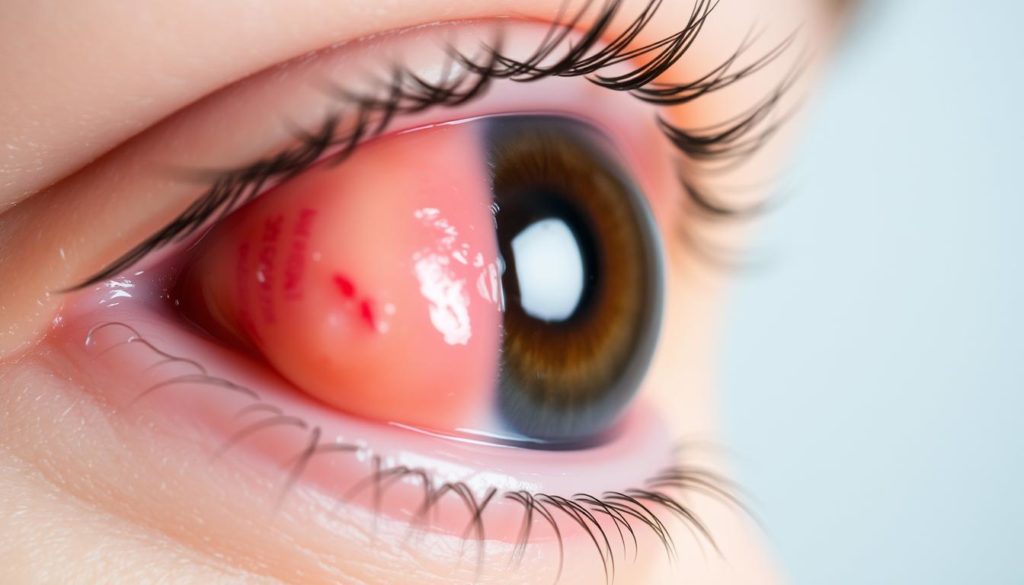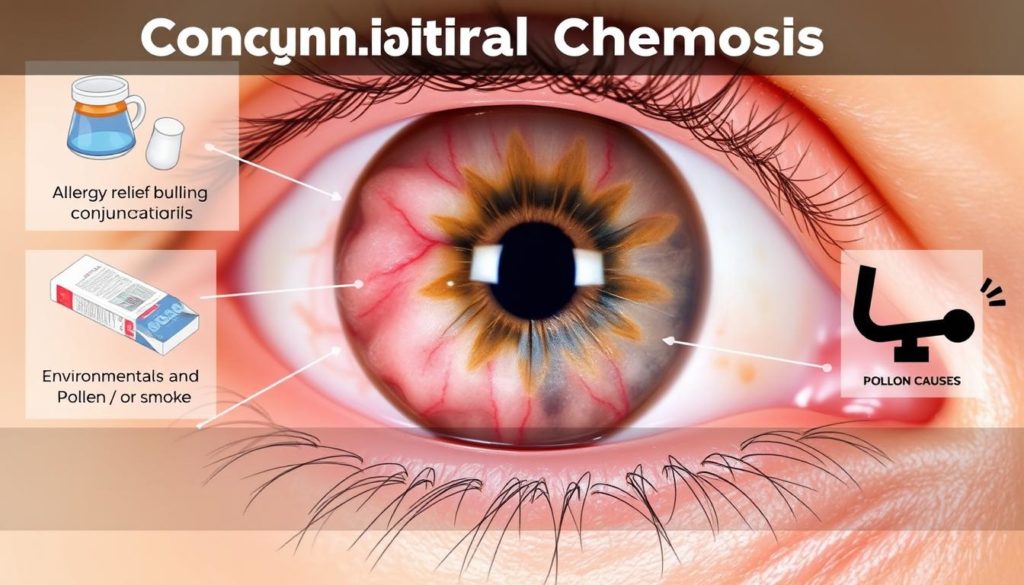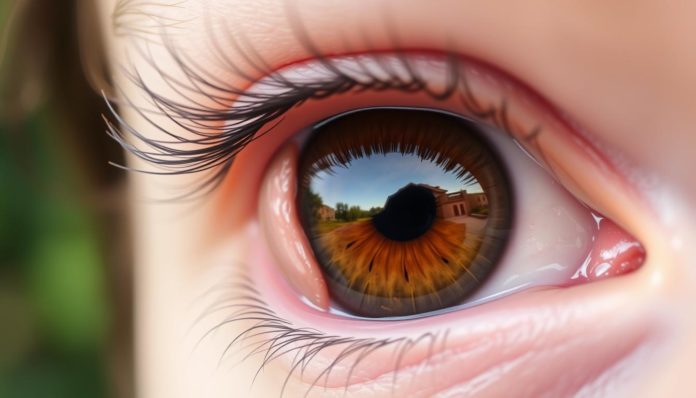Did you know that conjunctival chemosis is the reason behind about 5% of all eye specialist visits in the U.S.? It’s a condition where the conjunctiva swells up. This swelling can be due to infections, allergies, or injuries to the eye. It’s important to get it checked early to keep your eyes healthy.
This condition shows up as a blister-like membrane on the eye. It’s more common than you might think and is different from other eye issues. With the right care, you can manage this condition well. This helps keep your eyes healthy and avoids further problems.
If you have swollen eyes from allergies or an injury, knowing about conjunctival chemosis is key. Learning about its causes and treatment options can help a lot. It’s vital to stay informed to look after your eye health.
What Is Conjunctival Chemosis?
Conjunctival Chemosis is a concerning eye condition. It’s known for making the conjunctiva swell. Let’s look into what it is, its symptoms, and what causes it.

Definition
This condition is spotted by serious eye inflammation. It makes the eye look like it has a blister. This happens when fluid builds up in the conjunctiva, the thin layer over the eye.
Common Symptoms
People with conjunctival chemosis often notice things like:
- Yellowish and watery eyes
- Difficulty in closing the eyes fully
- Puffiness around the eye area
Why It Happens
The reasons behind conjunctival chemosis are different for everyone. It could be allergies, infections, reaction from surgery, or an injury to the eye. Knowing what causes it is key to treating and avoiding it.
Common Causes of Conjunctival Chemosis
Knowing why conjunctival chemosis happens is key to treating it fast and well. Many things can lead to it, like infections, allergies, and eye injuries. By spotting these causes early, people can avoid or lessen eye irritation, cutting down chemosis risks.
Infections
Bacterial or viral conjunctivitis, also called pinkeye, is a top reason for conjunctival chemosis. These infections cause a lot of eye irritation, puffiness, and redness. Washing hands often and keeping away from sick people are good ways to stop spreading pinkeye.
Allergies
Allergies also play a big role in conjunctival chemosis. Around 40% of folks in the modern world get allergic conjunctivitis, leading to chemosis sometimes. Things like pollen, animal fur, and dust mites can really irritate the eyes and make them puff up.

Eye Injuries
Injuries to the eye, from surgery like blepharoplasty or accidents, can trigger conjunctival chemosis too. These injuries start swelling and puffiness around the eyes. Wearing safety gear for certain activities and taking great care after surgery can lower chemosis risks.
Recognizing the Symptoms of Conjunctival Chemosis
Spotting early signs can greatly help in treating Conjunctival Chemosis. It’s important to watch for specific symptoms of the conjunctiva. This can lead to better chances of healing.
Blister-like Swelling
A key symptom is the conjunctiva’s blister-like swelling. This swelling sticks out, looking like a bubble or blister. It often brings a lot of discomfort to the eye.
Seeing swollen eyes can be concerning because they appear suddenly and are very noticeable.
Difficulty Closing Eyes
Having trouble fully closing the eyes is another major sign. Swollen conjunctiva can block the eyelids from shutting normally. This makes it hard to blink or let the eyes rest and is a concern for looks too.
Watery and Yellowish Eyes
Watery, yellowish eyes often point to Conjunctival Chemosis. The buildup of fluid in the conjunctiva leads to ongoing watery eyes. This might mix with a yellow color. Swollen, watery eyes can be upsetting and don’t look good.
To wrap up the symptoms, here’s a table summarizing the main things to look for:
| Symptom | Description |
|---|---|
| Blister-like Swelling | Notable bubble-like bulge in the conjunctiva |
| Difficulty Closing Eyes | Swelling interferes with eyelid movement |
| Watery and Yellowish Eyes | Continuous watery discharge, sometimes yellow |
How Allergies Trigger Conjunctival Chemosis
If you have eye allergies, it’s important to know how allergens affect your eyes. This knowledge can help you take control of your symptoms.
Allergic Conjunctivitis
Allergic conjunctivitis happens when specific allergens irritate the eyes, causing redness and swelling. Things like pollen, dust mites, and pet dander make the body’s immune system overreact. This can make your eyes itchy, red, and watery.
This reaction can make the conjunctiva in your eyes swell up. This swelling is called conjunctival chemosis.
Common Allergens
There are a few common allergens that can cause allergic reactions in the eyes including:
- Pollen from trees, grass, and weeds
- Dust mites
- Pet dander
- Mold spores
- Industrial pollutants
Sometimes, certain foods and medicines can also cause allergies. Knowing what triggers your allergies and staying away from them is key to managing conjunctival chemosis.
Treatment Options for Conjunctival Chemosis
Conjunctival chemosis can be an issue, but there are good treatments available. Knowing these treatments can help patients better manage their symptoms.
Cold Compresses
Using eye treatments like cold compresses is simple and easy. Putting a cold pack on the area lowers swelling. It also brings quick relief.
Artificial Tears
Artificial tears are a well-liked eye treatment. They ease irritation and dryness from conjunctival chemosis. Using these wetting drops often helps ease pain and aids in healing.
Medications
In worse cases, medicine may be needed. Antihistamines are used for allergic reactions, a common chemosis cause. Steroids are also used to lessen inflammation and handle tough symptoms. Sometimes, ocular decongestants are advised to help with eye health.
| Type of Treatment | Purpose | Common Medications |
|---|---|---|
| Cold Compresses | Reduce swelling | None |
| Artificial Tears | Relieve dryness | Various brands |
| Medications | Treat allergies and inflammation | Antihistamines, Steroids |
Preventing Conjunctival Chemosis
To prevent conjunctival chemosis, first understand the common triggers and take the right steps to avoid them. By knowing what causes your eye irritation, you can keep your eyes healthier. This will also decrease the chance of getting this condition.
Identifying Triggers
It’s key to know what specifically causes conjunctival chemosis. Triggers can be allergens like pollen, dust, and animal fur. Environmental factors like dirty air or lots of pollen matter too. Keeping track of when your symptoms pop up can show you patterns and triggers.
Preventive Measures
There are effective ways to cut down your risk of getting conjunctival chemosis. Here’s what you can do:
- Control exposure to known allergens by keeping windows closed during high pollen seasons.
- Maintain good ocular hygiene by washing hands often and not touching your eyes.
- Wear protective eyewear in places where your eyes might get hurt or irritated.
Conjunctival Chemosis After Eye Surgery
Taking care of your eyes after surgery is key to avoid problems like conjunctival chemosis. Learning about its causes and proper care can greatly lower surgery risks.
Types of Surgeries
Many eye surgeries can lead to conjunctival chemosis, such as:
- Blepharoplasty
- Cataract surgery
- Lasik surgery
These surgeries can upset the balance of eye tissues, causing swelling and inflammation. Conjunctival chemosis is often seen after blepharoplasty due to eyelid work. Read more about it here.
Post-Surgical Care
Good eye care after surgery is crucial for recovery. Patients may need eye drops or ointments to lessen inflammation and help healing. In severe cases, wearing an eye patch might be suggested to lessen the swelling and protect the eye.
- Anti-inflammatory medications: These lower inflammation and ease symptoms.
- Ocular lubricants: They keep the eye moist to avoid more irritation.
- Additional surgical interventions: Sometimes, more surgery is needed to fix ongoing chemosis.
Regular check-ups with healthcare professionals are important. They can spot issues early on. For deeper insights into conjunctival chemosis causes and how to deal with them, check out this detailed article.
When to Seek Medical Help
Conjunctival chemosis is usually manageable at home. Yet, you must seek medical help in certain cases. If home care doesn’t fix the symptoms, see a doctor. This shows there might be a bigger issue that simple treatments can’t solve.
Not being able to close your eye fully is a serious sign. This problem could cause dryness, more irritation, or an infection. Getting medical advice ensures you get the correct treatment for your situation.
Don’t ignore eye pain, changes in vision, or allergic reactions like hard breathing. These could mean serious trouble needing quick doctor’s care. Fast action helps avoid lasting harm and gets you the right help for your eyes.
FAQ
What is Conjunctival Chemosis?
Conjunctival Chemosis is a swelling of the conjunctiva. It looks like a blister on the eye. It’s often due to infections, allergies, or injuries.
What are common symptoms of Conjunctival Chemosis?
Symptoms include watery, yellowish eyes and swollen conjunctiva. It also makes closing the eyelids hard.
Why does Conjunctival Chemosis happen?
It can be caused by infections, allergies, surgery, or eye injuries. These factors lead to swelling.
How do infections lead to Conjunctival Chemosis?
Infections like pinkeye cause it. They inflame and swell the conjunctiva.
Can allergies cause Conjunctival Chemosis?
Yes, allergic reactions can cause it. They inflame and swell the conjunctiva too.
How do eye injuries contribute to Conjunctival Chemosis?
Injuries or surgeries like blepharoplasty can cause it. They lead to swelling and inflammation.
What is blister-like swelling in Conjunctival Chemosis?
It’s when the conjunctiva swells up and looks like a blister. This happens in Conjunctival Chemosis.
Why is it difficult to close the eyes fully with Conjunctival Chemosis?
Swelling prevents the eyelids from closing properly. This can make your eyes uncomfortable and irritated.
What causes watery and yellowish eyes in Conjunctival Chemosis?
Inflamed conjunctiva produce more fluids. This makes the eyes watery and yellowish.
What is allergic conjunctivitis?
It’s when the conjunctiva gets inflamed due to allergies. Pollen or dust mites can trigger it.
What are common allergens that trigger Conjunctival Chemosis?
Pollen, dust mites, and pet dander are common triggers. Foods and medications can also cause reactions.
What treatment options are available for Conjunctival Chemosis?
Treatments include cold compresses, artificial tears, and medicines. These can reduce inflammation and allergic reactions.
How can cold compresses help with Conjunctival Chemosis?
They reduce swelling and soothe the inflammation. This brings relief from discomfort.
Can artificial tears be used to treat Conjunctival Chemosis?
Yes, they keep the eyes lubricated and reduce irritation. They help those with Conjunctival Chemosis feel better.
What medications are recommended for treating Conjunctival Chemosis?
Antihistamines, steroids, and ocular decongestants are advised. They help manage symptoms and reduce inflammation.
How can one prevent Conjunctival Chemosis?
Identify your triggers and practice good eye hygiene. Wear protective eyewear to avoid injuries.
What are preventive measures to avoid Conjunctival Chemosis?
Limit exposure to allergens and maintain eye health. Also, use protective eyewear to prevent injury-related Conjunctival Chemosis.
What types of eye surgeries can lead to Conjunctival Chemosis?
Blepharoplasty, LASIK, and other eye surgeries can lead to it. This is due to trauma and inflammation.
What is included in post-surgical care for Conjunctival Chemosis?
Care includes eye drops or ointments and eye patches. Sometimes, more surgeries are needed to help the condition.
When should medical help be sought for Conjunctival Chemosis?
Seek help if symptoms last, closing eyelids is hard, or you have eye pain. Also, if you have signs of allergic reactions, like trouble breathing, see a doctor.


